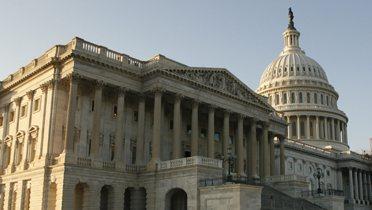ABSTRACT
We present new estimates of the budget outlook, incorporating the impact of the recent debt-limit deal and the latest projections by the Congressional Budget Office and the Medicare and Social Security Trustees. Although the official budget figures have improved relative to a year ago (as a result of the debt-limit deal and lower interest rate projections), realistic budget projections show that the medium-term outlook remains troublesome and the long-term outlook remains unsustainable. Even with the recent legislation in place and the economy recovering fully by 2017, as projected by CBO, on a path following current policy with respect to taxes and spending (for example, by making the Bush tax cuts permanent and indexing the alternative minimum tax for inflation), deficits will exceed $8 trillion (4 percent of GDP) over the next decade, with the debt-GDP ratio exceeding 80 percent by 2021 and continuing to rise thereafter.
While the long-term budget outlook is sensitive to assumptions about how health care spending will respond to recent legislation and how durable the provisions of the recent budget deal will be, even the most optimistic assumptions imply a long-term fiscal gap of about 5.5 percent of GDP under current policies, and less optimistic but still plausible assumptions generate fiscal gaps of almost 10 percent of GDP. Policymakers and the public will eventually be forced to address these issues. Addressing them soon rather than later will allow for more reasonable and gradual adjustments.
INTRODUCTION
The United States faces the prospect of large federal fiscal deficits in the immediate future, the next 10 years, and the longer term. Although perhaps subject to the greatest public attention, criticism and expressions of concern, the short-term deficits — the result of the tax cuts and spending increases of the last decade, the “Great Recession” and economic policy adjustments that responded to it — are generally thought to be helping the economic recovery, even though the recovery has been very weak to date. In contrast, the medium-term deficits projected for the next 10 years and the long-term deficits projected beyond 2021 are a source of concern. Even if they do not lead to an immediate crisis, these medium- and long-term deficits will nevertheless create growing and serious burdens on the economy.
The unsustainability of federal fiscal policy has been discussed since at least the 1980s. But the problem has increased in importance and urgency in recent years, for several reasons. First, the medium-term projections have deteriorated significantly. Second, the issues driving the long-term projections — in particular, the retirement of the baby boomers and the aging of the population and the resulting pressure on Medicare and Social Security — which were several decades away in the 1980s — are now imminent. Third, there are increasing questions about the appetite for U.S. debt on the part of foreign purchasers, including some who have voiced their concerns quite publicly. Fourth, many countries around the world and many of the U.S. states now face daunting fiscal prospects themselves, creating a more challenging environment for any attempts at U.S. fiscal consolidation. In light of these issues and the recent agreement to raise the debt limit that included provisions aimed at dealing with the U.S. fiscal imbalance, this paper provides new projections of the federal budget outlook. [1].
The biggest change in the policy and economic environment relative to prior analysis results from the recent budget deal that President Obama signed into law on August 2, 2011 (Pub. L. No. 112-25). The measures contained in the Budget Control Act of 2011 would reduce the deficit in two phases. The Act first uses discretionary spending caps and program integrity initiatives to reduce the deficit by a cumulative amount of $895 billion over ten years (CBO 2011c). The legislation also establishes a bipartisan Joint Select Committee on Deficit Reduction to identify and recommend an additional $1.5 trillion in deficit savings by November 2011. Unless proposals from the Joint Select Committee are enacted and projected to reduce deficits by at least $1.2 trillion over 10 years, the Budget Control Act specifies automatic spending cuts to achieve the difference between the required $1.2 trillion and any deficit savings on which Congress and the president can agree.
With the debt deal in place, CBO (2011c) projects the fiscal-year 2011 deficit to be $1.3 trillion, about 8.5 percent of GDP. Other than 2009 and 2010, this represents the largest deficit as a share of the economy since World War II. For 2012–2021, the CBO baseline projects a cumulative deficit of $3.5 trillion, with deficits declining sharply to 1.1 percent of GDP by 2015 and hovering between 1 and 1.5 percent of GDP through 2021.
This would be a reassuring outcome, at least for the medium term, except that the CBO baseline is not intended to represent likely or probable outcomes. Rather, it essentially reports the implications of the assumption that Congress does nothing over the next 10 years. All major tax provisions currently scheduled to expire are assumed to do so as scheduled, for example.
An alternative way to project future outcomes is to assume that future Congresses will act more or less like previous Congresses, for example in granting continuances to expiring tax provisions. To generate a better measure of where fiscal policy is headed, we alter the CBO baseline assumptions in ways that we believe are more representative of current policies. Under this extended policy scenario, we estimate a 10-year deficit of $8.1 trillion, or 4.1 percent of GDP. As in CBO’s baseline, deficits decline in the near term, but only to 3.4 percent of GDP by 2015, and unlike in CBO’s baseline, deficits then rise substantially.
By 2021, although the economy is projected to have been at full employment for several years, the deficit under these alternative assumptions rises to 4.3 percent of GDP, the debt-to-GDP ratio rises to 80.3 percent (the highest since 1948), and net interest payments rise to 3.4 percent of GDP (the highest share ever ).
The estimates above, for the 10-year horizon and the debt-GDP ratio headed into the next decade, are significantly improved relative to those from earlier this year (Auerbach and Gale 2011). The 10-year extended policy deficit has fallen from $11.8 trillion (6.0 percent of GDP) in those estimates to $8.1 trillion (4.0 percent of GDP) currently. Of the $3.7 trillion difference, about $2.1 trillion is due directly to the debt-limit deal (and to the less-than-certain assumption that it will be enacted and enforced as legislated), another $770 billion or so is due to lower interest rate assumptions by the CBO (which presumably are also due in part to the debt-limit deal and its impact, through lower deficits, on interest rates), about $430 billion is due to our no longer assuming that discretionary spending grows with population (since the debt-limit deal specifies the path of discretionary spending), and the rest is due to changes in a variety of economic and technical assumptions by CBO.
After 2021, the deficit and debt/GDP ratios are poised to rise further, with revenues growing much more slowly than spending, implying that the situation is unsustainable. The debt-to-GDP ratio will pass its 1946 high of 108.6 percent late in the 2020s under extended policy and around 2040 under the CBO baseline. Under both scenarios, however, the debt-to-GDP ratio would then continue to rise rapidly, contrary to its sharp decline in the years immediately after 1946.
To examine long-term issues more formally, we estimate a long-term fiscal gap — the immediate and permanent increase in taxes or reduction in spending that would keep the long-term debt-to-GDP ratio at its current level. Using current-law assumptions for Medicare spending, as put forth by the Medicare trustees (2011), and assuming that the budget cuts enacted in the recent debt deal are not only enforced as legislated over the decade, but also persist for the indefinite future, we find that the long-term fiscal gap is about 3.3 percent of GDP under the assumptions in the CBO baseline and 5.5 percent of GDP in the extended policy scenario. However, these estimates hinge critically on the evolution of health care spending and on assumptions about whether the debt deal’s effects will persist beyond 10 years. The long-term gap rises by almost 3 percent of GDP under each of these scenarios when substituting the Medicare outlay estimates put forth by the Medicare actuaries (CMS Office of the Actuary 2011) and rises by additional 1 percent of GDP when using assumptions employed by CBO (2011b). Under each of the various health care scenarios, the fiscal gap rises by an additional 0.4 percent of GDP under the assumption that the debt deal’s restrictions are enforced for a full decade, but not thereafter.
These estimates show that health care reform is an important part of the long-term budget outlook, but also that even very substantial and sustained reform of health care will leave a significant fiscal gap. They also demonstrate quite forcefully that the debt-limit deal, as painful as it was to achieve, is only a prelude to the much bigger adjustments that will be needed in the coming years.
[1] This paper builds on analysis and conventions developed in previous papers, including Auerbach and Gale (1999, 2000, 2001, 2009, 2010a, 2010b, 2011), Auerbach et al. (2003), and Auerbach, Furman and Gale (2007, 2008).





